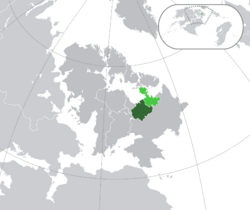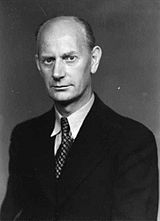West Ruthen
This article is incomplete because it is pending further input from participants, or it is a work-in-progress by one author. Please comment on this article's talk page to share your input, comments and questions. Note: To contribute to this article, you may need to seek help from the author(s) of this page. |
People's Republic of Ruthen Volksrepublik Ruthen (Ruthish) | |
|---|---|
| Motto: Arbeiter aller Länder, vereinigt Euch! | |
| Anthem: "Der Rote Hahn" "The Red Rooster" | |
 Territory controlled | |
| Capital and largest city | Thessen |
| Official languages | Ruthish Hyacinthean |
| Ethnic groups (2020) | 83.5% Ruthish background 16.5% Other background |
| Religion (2020) | 52.8% Gregorianism 40.3% Irreligious 6.9% Others |
| Demonym(s) | West Ruthish · Ruthish |
| Government | Federal socialist republic |
| Gunnar Schönau | |
| Tilmann Rosenblatt | |
| Otto Thoma | |
| Natali Mannheim | |
| Legislature | National Political Council |
| Establishment | |
| 9 December 987 | |
| 9 September 1438 | |
| 27 February 1862 | |
| 28 November 1864 | |
| 14 July 1943 | |
| 13 August 1945 | |
| 30 October 1977 | |
| Area | |
• Total | 327,806 km2 (126,567 sq mi) |
• Water (%) | 1 |
| Population | |
• 2023 estimate | |
• 2020 census | |
• Density | 202.50/km2 (524.5/sq mi) |
| GDP (PPP) | 2020 estimate |
• Total | |
• Per capita | |
| GDP (nominal) | 2020 estimate |
• Total | |
• Per capita | |
| Gini (2020) | low |
| HDI (2022) | very high |
| Currency | Ruthische Mark (ʀ) (WRM) |
| Time zone | UTC+0 (Central Calesian Time, CCT) |
• Summer (DST) | UTC+1 (Central Calesian Summer Time, CCST) |
| Date format | dd-mm-yy |
| Driving side | left |
| Calling code | +25 |
| Internet TLD | .vr |
West Ruthen (Ruthish: Westruthen), officially the People's Republic of Ruthen (PRR; Ruthish: Volksrepublik Ruthen; VRR), is a sovereign country in Central Calesia. The country's northern border is defined by its coastline with the Swarin Sea as well as Dutchland. To the east it shares a border with East Ruthen along the Ruthish Demilitarised Zone although it claims sovereignty over the entirety of East Ruthen. It shares several borders with other states in the south. In the west it borders Hyacinthe and Dahemia. West Ruthen claims to be the sole legitimate Ruthish government. It has a population of 65.46 million people and a total land area of 327,806 km2 (126,567 sq mi). The capital and largest city of West Ruthen is Thessen which lies in the Lonane Arc conurbation; other significant major urban areas include Schwechat, Hallschlag, Höhn, Ratekau and Lüchow.
The area encompassing greater Ruthen has been inhabited since the Paleolithic era and from the Neolithic era by various Celts and later Waldic tribes in the north of the country. The area to the south of the Hunsrück river which today forms the boundary between East and West Ruthen fell under the control of the Hernician Empire who first named the area Maior Ruthenia. After the fall of the Hernician Empire by tribes such as the Ruthenii, various Waldic states emerged before eventually being united into the first North Ruthenic Kingdom. Ruthen enjoyed a period of relative stability until the Catabolic Crisis which saw the collapse of the North Ruthenic Kingdom in 1355. The subsequent Ninety Years' War and the Peace of Sallahn led to the creation of the Ruthish Confederation which saw Ruthen re-emerge as a major power in North Central Calesia albeit as a loose confederation of several dozen independent states. During the !Reformation, the Ruthish Confederation was divided on religious lines with the northern and coastal regions falling under the influence of states loyal to the Northern Cathedralist Church whilst states more central in the Confederation remained loyal to the Presterist church.
The Renaissance in the 17th century allowed for the development of liberal and pan-Ruthenic thought, advancements in technology and communication also allowed these ideas to spread more rapidly throughout the Confederation. The Twelve Years' War and Elizabeth Square Declaration in Falland were the catalysts for events in Ruthen as liberal bourgeois revolutionaries were able to seize swathes of territory. The Thessen Parliament in February 1862 saw the first Ruthish Constitution adopted by Radical and Liberal politicians and the establishment of the constitutional Kingdom of Ruthen in 1864 after the War of Ruthish Unification. Ruthen was a key colonial power during the late 19th century, openly pursuing the creation and expansion of overseas colonial holdings culminating in the establishment of one of the largest Calesian empires at the time. In the late 19th and early 20th centuries, Ruthen became deeply politically divided between the emerging socialist parties and the governing liberal parties which sparked the Roter Sommer in 1923.
During the Great War, Ruthen was a core member of the Sydenham Powers and mainly fought in its overseas territories with the aim of seizing Waldish colonies. The war's unpopularity at home combined with significant socialist civil unrest and the failure of peace talks saw the Ruthish government collapse and a new emergency interim government was established which created the short lived Ruthish Republic prior to surrendering. The post-war Joint Occupation Authority in Ruthen between Waldrich and Hyacinthe collapsed during the 1944 Ruthish Crisis which saw a socialist government installed in Ruthen and Declaration of the Ruthish Republic. The People's Republic of Ruthen was established shortly afterwards on 13 August 1945 and initially enjoyed far more political and diplomatic legitimacy as the official sole Ruthish state. In July 1999, West Ruthen invaded East Ruthen sparking the Six-Day War and the establishment of the Ruthish Demilitarized Zone and the United Congress Monitoring Authority for Ruthen (UCMAR).
West Ruthen is a federal socialist republic with an indirectly elected legislature and government in accordance to the 1977 Constitution and since the turn of the millennium has experienced a period of general political stability and economic development. West Ruthen has one of the world's highest ranks in the Human Development Index with high levels of income equality and a robust welfare state and economy dominated by co-operative industries. It has been a member state of the United Congress since 2001 as part of the Inter-Ruthish peace process. West Ruthen enjoys close ties to the socialist and developing world and is one of the largest providers of foreign aid to developing countries; it is a member state of the Global Socialist League.
Etymology
History
Prehistory
Hernician era
North Ruthenic Kingdom
Ninety Years' War
Ruthish Confederation
Reformation
Emergence of Nationalism
Kingdom of Ruthen
Ruthish Colonial Empire
Great War and Occupation of Ruthen
Establishment of the People's Republic
Gmehling-Ära
Mahlau-Ära
Grenzpolitik
Six-Day War
Contemporary history









